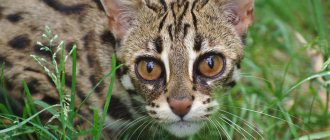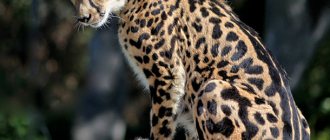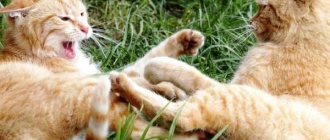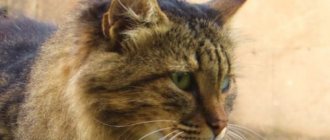Indoor and outdoor “runners”
Cats are far from running marathons; they are sprinters by nature.
It is quite logical that cats who live on the street, or who often find themselves there, need good athletic shape. They hunt birds and mice, which are not so easy to catch if you are physically unprepared. And most importantly, they often have to escape from dogs, otherwise they won’t survive. Domestic “fluffies” generally live freely - they only remember hunting as a game, when the owners offer them to catch a toy mouse or a bow on a string. Their bowl is always full, so there is no need to get food for themselves, and in general, the owners take care of everything. And you have to save yourself only from the master’s slipper.
In any case, a cat cannot run at high speed for long. If she does this to escape, she usually climbs a tree or otherwise hides from danger. But, if there is no shelter, then the animal may begin to suffocate and even die, since its heart is not adapted to such stress.
Cheetah
The cheetah is the fastest predator in the world.
This is a species of the cat family, which is noticeably different in its structure from other representatives of its family. This is a large cat with developed muscles, a very slender body with almost no fat deposits, which makes the cheetah even seem too thin and fragile. But it is precisely its lightness and slenderness, as well as the special structure of its head - small, smooth, with small round ears - that give this predator the ability to develop enormous speeds. A cheetah can accelerate to 75 kilometers per hour in just two seconds (which can be compared to the fastest racing car in the world), and the maximum speed of these cats reaches 120 kilometers per hour. Thanks to their speed, cheetahs are excellent hunters; they hunt hares, gazelles, wildebeest and other small animals. They do not use the common tactics of attacking from behind bushes or shelters among cats, but openly pursue their prey. But such races deprive them of their strength, so cheetahs have to rest for half an hour after a successful hunt.
Cheetahs are found in India, Africa and Asia, but the activities of poachers are gradually causing these unique predators to become extinct; in many countries they have already completely disappeared.
The fastest cats
What helps the fastest cats run
Among purebred cats, the Egyptian Mau is considered the record holder for speed. He was lucky with the structure of his hind legs, which have leathery folds at the base. Due to them, while running, the step reserve and amplitude of movements increase, and therefore the speed increases.
The normal speed of cats (on average) is 13.5-13.8 km/h. If a cat moves at a leisurely trot, then it will barely overtake a walking person, and its speed will be about 8 km/h. Whereas the maximum speed of cats is 50 km/h.
The fastest cats in the world
Wild cats are fast and agile animals that are excellent hunters. Even a domestic cat can run at a speed of 40 km per hour. The pet will not be able to cover a long distance at this pace. He will be able to make a tiny leap. Wild cats have greater endurance, so they are able to run at high speed for much longer.
When measuring indicators, the distance and time it takes the animal to cover the distance are taken into account. There are many cats in nature that are capable of running with incredibly high agility.
Sixth place – Puma
The predator runs very quickly over short distances. The animal is capable of reaching speeds of up to 75 km/h. That is, a cougar can even catch up with a car that is not going too fast.
In the United States of America, the cougar is commonly called the “mountain lion.” The name is associated with the animal's habitat. The predator can be found not only in forests, but also in the mountains. Moreover, the puma is found even in the jungle and swamps.
Differs in large sizes. Together with the tail, the body reaches 2 meters in length. At the same time, the weight is not too large - from 50 to 100 kg. Much depends on gender and individual characteristics. Due to its well-developed muscles and light weight, the Puma is able to run quickly and hunt deftly.
The fastest wild cat breeds
The cat family includes 41 species of wild cats. They all vary in size, color and behavior. And among them we can single out the fastest.
Cheetah and jaguar
The cheetah is the fastest animal, possessing the greatest speed not only of the cat family, but of all animals on Earth. In just 2 seconds it accelerates to 65 km/h and, in pursuit of prey, reaches speeds of up to 110 km/h. The cheetah has a graceful, lean body and well-developed muscles. The weight of the predator is small and reaches 65 kg, it has almost no fat layer. The slender silhouette seems fragile, but this is a deceptive impression. This body structure allows you to achieve incredible speed.
In appearance, cheetahs resemble the graceful Russian greyhound. Like these dogs, cheetahs have blunt claws that hardly retract, they also do not climb trees well, they prefer to stalk their prey rather than sit in ambush, and they never feed on carrion.
Incredibly fast Cheetah
The Jaguar can reach a top speed of 80 to 100 km/h. Although it is capable of reaching such speeds, the cat can only last a short amount of time while chasing prey. The jaguar's main method of hunting is ambush in tall grass.
The jaguar's body length can reach up to 180 cm in length, and its weight can be more than 90 kg. It is very similar to a leopard in its appearance, but is much larger in size.
Beautiful Jaguar
Panther and lion
The panther stands out for being considered the most dangerous predator on the planet. The character of these cats is secretive and inventive. When hunting, they prefer stalking and surprise attack tactics. They strive to immediately knock the victim down so as not to have a long chase. The maximum speed that a black panther can reach is 88 km/h, but only over short distances.
Fabulous Black Panther
the lion is called the “king of beasts.” The weight of individual individuals can be above 250 kg. It is noteworthy that, despite all their external greatness, lions cannot be classified as especially hardy animals.
The lion is capable of reaching speeds of 80 km/h over short distances and jumping 10 meters. Since it is difficult for lions to maintain high speed for a long time, they prefer to get close to their prey as inconspicuously as possible. Most often, the predator hunts at short distances and overtakes the prey with a swift jump. As a rule, lionesses are lighter and faster than males, therefore they are more successful in hunting.
Majestic Lion
Snow leopard and puma
The snow leopard is also called the "irbis" or "snow cat". This very secretive cat can run at speeds of up to 80 km/h for short distances. The long tail helps the snow leopard maintain its balance while jumping, and it jumps over a distance of more than 10 meters. The snow cat has short, strong legs and a bushy, long tail that helps balance when running at high speed. The total length of the animal can reach 2.3 meters, this is the length of the body including the tail. The total weight of an adult male snow leopard is 45-55 kg, females - no more than 35-40 kg.
The snow leopard has adapted to live in the harsh conditions of the highlands. The highest point at which a snow leopard was spotted is 6 km above sea level.
Secretive Snow Leopard
The puma is capable of running a short distance at a speed of 75 km/h. The animal can grow to a very impressive size - up to 2 meters. A typical adult male puma weighs 60-80 kg, females weigh less. The puma's body is flexible, its paws are wide, and its tail is long and muscular. Thanks to its light weight and well-developed muscles, the puma is a fast and agile cat.
Delightful Puma
Dune cat
Dune cats have very thick fur and strong, muscular legs. Even the pads are covered with fur to protect cats from the hot sand.
They live in hot, dry areas. These felines prefer to hunt at night. Dune cats have the ability to accelerate to 40 km/h. The main danger for them is from birds of prey and snakes (by the way, they can easily cope with some of them). The peculiarity of this cat is that it can easily do without water, receiving all the necessary fluid from food.
Egyptian Mau
The fastest representatives of domestic cats are considered to be the Egyptian Mau (“Mau” means cat). The maximum record of these miniature darlings is acceleration to 58 km/h (over short distances). All zoologists claim that if these animals had larger dimensions, they could well compete with the cheetah for the title of the fastest animal on the planet.
How people in Stepanakert, under fire, are trying to remain human
Kommersant correspondent Alexander Chernykh, while in Stepanakert, noticed a German shepherd near the press center of the government of the unrecognized Nagorno-Karabakh Republic - friendly, happy to everyone who strokes it. And then I met people who, in the context of the ongoing war, in every possible way support cats and dogs who were left - temporarily or forever - without their owners.
Near the press center of the government of the unrecognized Nagorno-Karabakh Republic there lives a German shepherd - friendly, happy to everyone who pets it. Every day I secretly brought her stew from the common table - and then I noticed that the press center employees, smiling guiltily, were bringing her food: “The owners left, so she came to us, waiting for them to return.” Over the course of a week in Stepanakert, I notice many affectionate dogs - they caress, lick their hands, rub against their legs; If you pat him on the head, they’ll walk with you for a couple of blocks. “There are now a lot of homeless pets in Stepanakert,” sighs Nune, a teacher of Russian language and literature at a local university (“You don’t need to give your last name, otherwise they’ll think I’m promoting myself.”) “When the city began to be shelled, people hastily packed up and left. , leaving the cats and dogs. I don’t want to judge anyone: not every driver would put an animal on a bus for several hours, especially when bombs are falling nearby. And where should they be taken? People went to distant relatives, to complete strangers. In Armenia, people are not yet accustomed to pets: they are ready to accept refugees, but not a cat or a dog. That’s why people left their animals in the city - they cried, but left without them.”
Nune and her friends are a rare exception for the region. Several years ago, they created the Facebook group “Animal Lovers in Artsakh” to rehome stray cats and dogs, and generally change society’s attitude towards them. “And you know, how sad it is to see on the streets those whom we previously adopted,” she complains, packing cat food in the lobby of the Europe Hotel. “A couple of years ago, we spent so long looking for owners for the cat Ryzhik. We found it and were so happy. And a week ago I was walking and I saw Ryzhik sitting in the yard again, all skinny. Of course, he recognized me, jumped down, and rubbed my legs. What can I do - the shops are closed, there is nothing to feed them. I'm not even talking about special food - about meat. The shops were closed for a week, without electricity - everything was ruined. They deliver humanitarian aid to people, but no one thinks about animals. And this is understandable - but my friends and I simply bleed when we see a purebred dog or cat on the street. It would be nice to eat near the garbage dumps, but the garbage dumps are empty now.”
Nune photographed several dogs on empty streets and posted them on Facebook. The post unexpectedly went viral; people from all over the world raised money, with which Nune’s friends bought several bags of feed in Yerevan. Now they are brought in on buses with humanitarian aid every couple of days. Members of the Facebook group who remained in the city divided Stepanakert into several sectors - and every day they deliver food to points known to them.
“The hotels have the most dogs,” explains Nune, leaving “Europe” with a bag of food. “People were centrally collected there and put on buses. And now the dogs come to the hotels every day, waiting for their owners to return. There are shepherds, and Dobermans, and huskies, and huskies... Only there are fewer and fewer of them every day - I hope they are scattering because of the constant bombing. I can’t think that they could die of hunger.”
Nune scatters food near the entrance to the hotel; Several beautiful dogs cautiously approach from behind the building - one is wearing an expensive leather collar. They wag their tails, but keep their distance. Dima, Nune’s friend in the Facebook group, takes out a bunch of “humanitarian” sausages. The dogs, having forgotten their fears, immediately run up to him - Dima does not even have time to peel the sausages from the casing.
“I think I saw this on the Internet,” Nune peers, “As soon as we wrote in the group that we would feed abandoned animals, their owners immediately started writing. They publish photos - “this is our Roy, this is our Naida, please feed them until we return.” People just cry at their monitors when they see in our photographs how their animals have become emaciated.”
Photo: Anatoly Zhdanov, Kommersant
Dima takes us by car to the “cat” points. There are not many of them, says Nune, cats know how to make themselves comfortable: “If a dog comes to the basement where people are hiding from bombings, then they will most likely drive him away. We usually have big dogs - well, it’s scary to put one in the basement. Especially when there is a bombing - they run around and bark. And the cats will sit in the corner, people even feel calmer when they are petted under the bombs.” And yet, some cats live in packs in yards where there are no basements, because they are afraid to go far from home. Nune pours food at the empty entrance - a beautiful Russian Blue immediately runs out from behind the door. Behind her is an ordinary tabby cat - but you can immediately see that she is well-groomed. Or rather, it was before. Nune shakes her head sadly: “You see, her eyes are sore? I wipe it with tea, but it hasn’t helped yet. We need medicines, but there aren’t enough of them for people, let alone animals.”
What you need to know about the conflict in Nagorno-Karabakh
Read more
Next we go to the market - there are no domestic cats there, but “Animal Lovers in Artsakh” feeds the market cats too. Previously, there were many barbecue and kebab shops on the market, the cats multiplied and were happy - but now the people have left, and there is no one to feed the animals. Nune’s phone rings, she speaks in a mixture of Russian and Armenian: “My life, how are you? Everything is fine, aren't you starving there? I kiss you, call mom sometimes, okay?”
This is Nune’s son calling, “from the first line” - that’s what they call the front here. “I did such a stupid thing,” she complains. “My son came home from the army in the spring, I gave him an iPhone for his 20th birthday. And now he’s gone off to fight again, but his iPhone doesn’t hold a charge, so he can’t even make a call. That’s why I answer all unfamiliar numbers - he asks the guys for their phone numbers, he always calls from someone else.”
Nune clarifies that her son, as the only child in the family, has the right to a benefit - he did not have to go to the front, he could have been sent to the rear. “But I raised my son to be a real Armenian,” Nune says proudly. “I didn’t say a word to him, but he went on his own, signed up, and is now in the forefront. He’s a real man, even if he’s only 20 years old.”
Cats run out from under empty counters - red, white, striped. Nune pours the food directly onto the asphalt - and they immediately pounce on the food. People pass by with stacks of lavash: the bakery at the market has started operating and is feeding everyone bread for free. “You know, I was afraid that I would be scolded: they say, there is a war here, we live under shelling, and they feed the cats... But no, I was wrong to think so - people smile and rejoice,” says Nune. “This is a sign of a peaceful life, people need it. And it calms me down. I’m terribly worried - I have a nephew there, at the front, a brother, a son... every morning begins with roll call. Pharmacies are closed, there is no valerian - at least cats and dogs help me.” Another cat emerges from under the blue tent - dusty and thin. She looks at us with festering eyes, and then carefully - sideways, sideways - approaches the scattered food. Tricolor. They say they bring good luck.
If you walk further through the market, you come across rows of vegetables. The smell of rotten meat hits your nose, and midges hover over the wooden boxes. The owners abandoned the goods at the end of September, when the city began to be shelled. The products were left to rot on the shelves: in the boxes I see melted tomatoes, cucumbers covered with fluffy mold, completely black bananas, shriveled corn, wilted peppers and eggplants. Even pineapples are found in one of the boxes; I sniff - sour.
Fighting in Karabakh. Summary for October 16
Read more
Photo: Anatoly Zhdanov, Kommersant
Residents of Stepanakert wander between the rows, looking for anything edible. A middle-aged woman in glasses, looking like a typical school teacher, is meticulously examining the tomatoes - as is customary at the market. Only this time they are all rotten: it is not clear what you can choose here. Adella is very embarrassed when I come up to talk: “I feel uncomfortable. Ugly. Don’t think that we always do this, we eat from the trash heap. This is uncharacteristic for us. It's just war now. There is humanitarian aid and canned food. A store near the house has opened - but there is only pasta. But the people in the basement want soup, something hot. So I came - suddenly something will be found. It’s a shame how you take it from the trash heap. But what can you do? It’s war.”
I guessed right: Adella worked as a chemistry teacher for many years, now retired. “In Soviet times, I lived in the Azerbaijani city of Mingachevir,” she says. “I was born here, I was little when my father decided to move. He was involved in construction, and his brothers lived there - they said the city was young, it was under construction, there would be a lot of work. And my father went and worked in the construction department. My mother was an Armenian school teacher there. I grew up, got married, returned here - and my parents still lived there. Until 1988."
Adella says that the turning point was the Sumgayit pogrom - after that, Armenians began to leave Azerbaijani cities en masse. “It seemed like everything was fine in Soviet times, but here it was as if a faucet was turned on and blood flowed,” she says. “Of course, they didn’t say anything officially, but we called the entire Union by phone. They learned about Sumgayit very quickly. And it became clear that genocide is repeating itself. It became clear: we had to leave our apartment, our furniture, everything we had, and flee to our homeland.”
How do they live on the Azerbaijani side of the contact line?
Adella’s parents did not leave the house for three days while the family in Stepanakert was looking for how to evacuate them: “But there were no cars, everyone was afraid. You have to go through Agdam, but there are already Azerbaijani rules there, it’s unsafe.” I remember how last week I tried to get to the shelled Agdam - by car the journey takes only about 40 minutes from the center of Stepanakert; like from one district of Moscow to another. It is impossible to imagine that this would be deadly. “In the end, there was one brave guy,” continues Adella. “He said: “I have a mustache, I look like an Azerbaijani.” They won’t stop me, I’ll go and pick up as many people as I can.” And so it happened.”
I can’t stand it and ask what seems to me a logical question in 2020:
- Your parents lived there for so many years - didn’t they really have Azerbaijani friends to help?
- You know, when my brother arrived from there, he took off his shirt and told me: “This is the shirt of Vagif’s neighbor. We collected things at night, I ran back and forth, and our Azerbaijani neighbors helped us - they watched to make sure no one came into the yard at night. When I got into the car, Vagif and I hugged, and he realized that my shirt was wet from sweat. Then he said - you can’t drive like that in the mountains at night, you’ll catch a cold. He took off his shirt and gave it to me.” That’s how it was too,” says Adella. “But still...
She points to her bag of wilted eggplants:
— I am a Soviet teacher, I have 45 years of experience. I lived in an international city, I have been an internationalist all my life. And now I don’t even know.
Leopard
This wild beast can accelerate to 63 km/h. The leopard never hunts on the ground; it catches its prey while in the trees. After the predator has waited for the right moment, it attacks with a sharp jump and, if necessary, catches up with its prey.
Speed is practically not important to them, despite the fact that the number on their “speedometer” is quite impressive - 60 km/h. When a leopard makes a jump, the tail serves as a rudder and helps make maneuvers. Having grabbed the prey, these predators, as a rule, drag it back to the tree and start eating there. They are able to adapt to any terrain. The patterns on a leopard's fur are individual and are never repeated in nature.
The tiger has also long been on the list of the fastest representatives among predatory cats. At short distances, it is capable of reaching speeds of up to 60 km/h. Just imagine that in pursuit of a victim they will be able to jump 5-6 meters in length (and in height, by the way, too).
But, even despite these physical abilities, not every tiger hunt is successful. These cats are very massive, their weight can increase up to 300 kg, and their body length (excluding the tail) can vary up to three meters. That is why, despite their physical dominance, they are significantly inferior to the cheetah in speed.
The puma (or mountain lion) consistently occupies sixth position in the world top of the fastest cats. These predators reach speeds of up to 75 km/h over short distances.
These large animals reach two meters in length (including tail). The weight of these cats reaches 100 kg. A well-developed muscular system and low weight contribute to the speed and agility of mountain lions. They can accelerate to 75 km/h.
Females are smaller in size than males. But, at the same time, they are not inferior to them in agility and speed.
Tiger | Speed up to 60 km/h
The tiger is one of the fastest felines in the world. Over short distances, the cat can reach speeds of up to 60 km/h. While chasing prey, they jump up to six meters in length and up to five meters in height. But despite this ability, only one hunt out of ten attempts ends in success. Tigers are quite heavy predators with a body weight of up to 300 kg and a body length without a tail of up to three meters. This is one of the reasons why their speed is significantly less than that of a lean cheetah.
Snow Leopard
This top is completed by the snow leopard. They are capable of jumping over a distance of 6-7 meters (the height of the jump reaches 3 meters). The leopard has short, but muscular and strong legs and a fairly long tail, which is necessary to maintain balance during a sprint. By the way, the maximum speed of this representative of the cat family can reach 80 km/h. The snow leopard is the highest mountain animal among all the inhabitants on the planet.
The first position in the ranking is still occupied by the cheetah. This spotted hunter is capable of reaching a speed of 112 km/h. in just 3 seconds. The maximum speed reaches 130 km/h. The length of one jump of this predatory cat can reach 7-8 meters. In addition, the cheetah is able to change the trajectory of its movement almost at lightning speed. That is why the victim has virtually no chance to escape the attack.
Sources:
https://zen.yandex.ru/media/id/592edbdf7ddde8b70fb1be78/5d50fdcda06eaf00ada8abb4 https://kipmu.ru/samye-bystrye-koshki-v-mire/ https://prokyr.ru/info/top-6-samyh -bystryh-kosek-v-mire-47297/











